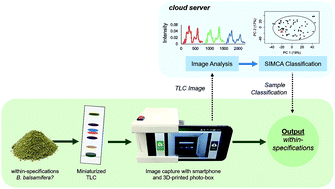Smartphone-based image analysis and chemometric pattern recognition of the thin-layer chromatographic fingerprints of herbal materials†
Abstract
Thin-layer chromatography (TLC) is commonly used as a screening method to verify the identity and quality of dried herbal medicinal plant material. While TLC is relatively simple, the method still requires technical experience and relies on the subjective classification of sample TLC profiles as “within-specifications” or “off-specifications.” In this work, we report the development of an objective TLC-based system for the identification and quality assessment of herbal medicinal materials. Our proposed system is a miniaturized Pharmacopeia-based TLC method coupled with a smartphone app that allows for an objective interpretation of TLC profiles via multivariate image analysis and chemometric fingerprinting. An image of the TLC profile is captured using a smartphone camera interfaced with a 3D-printed photo-box, and the analysis is automated using a framework of pre-uploaded algorithms hosted on a cloud server. The TLC profile image is converted to an unfolded red, green, and blue (RGB) channel intensity profile, and classified as “within-specifications” or “off-specifications” using aggregated Soft Independent Modeling of Class Analogy (SIMCA) models. We present the application of our system to two herbal medicinal plants, Blumea balsamifera and Vitex negundo. The proposed system demonstrates 90.2% sensitivity and 86.2% specificity for B. balsamifera classification, and 81.4% sensitivity and 92.0% specificity for V. negundo classification when compared to the respective laboratory-based Pharmacopeia TLC protocols for the ability to distinguish authentic samples from non-authentic and degraded samples. The system developed in this work is a cost-effective, rapid method that can serve as a herbal material quality assessment tool in resource-limited settings.



 Please wait while we load your content...
Please wait while we load your content...
